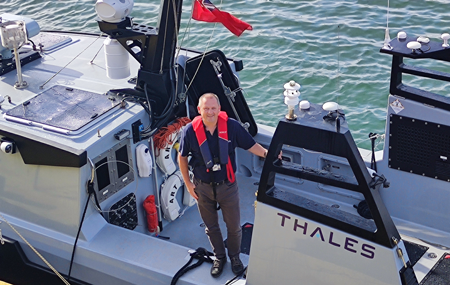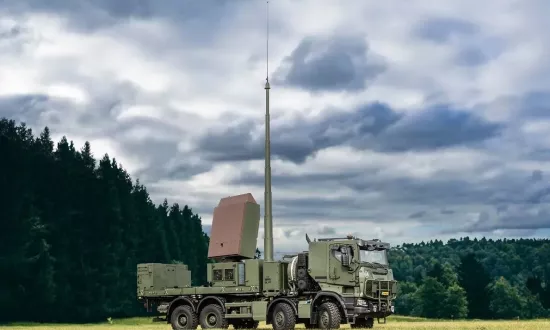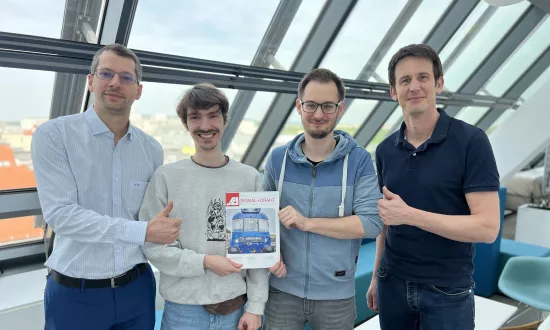Defeating maritime mines: an engineer’s perspective

Few of us will ever create something of lasting international importance. Senior Systems Engineer Neil Coleman, who led a four-year project to develop the world’s first fully-integrated autonomous mine countermeasures solution, is one of the few. As the final evaluation approaches, Neil takes questions on the toughest challenge of his career to date.
Can we just clear something up? Your job title describes you as an engineer, but you don’t seem to fit the ‘nuts and bolts and plenty of grease’ stereotype.
The term ‘engineer’ is very broad. There are hundreds of different types. I happen to be a systems engineer, responsible for creating systems of systems. All engineers share a single goal, though. We solve problems.
What is the problem that you’ve solved with this project?
How to detect, identify and defeat maritime mines quickly and without risk to lives. Until now, it’s been a very slow, extremely dangerous task but we’re using unmanned autonomous technology to fix that.
Is mine warfare much of an issue these days?
It’s a huge issue. Sea mines left over from both World Wars and the Cold War are frequently found along the coasts of Northern Europe, the Baltic and some parts of the Mediterranean.
What’s more, rogue states and terror groups now have the capabilities to lay inexpensive, improvised sea mines, which can be built and deployed for a couple of thousand dollars. And the mines don’t even have to be real. A credible threat could temporarily shut a port, disrupting shipping and upsetting the economy. In the UK, for example, half of all our fuel and food reaches us through the sea and most of the shipping passes through narrow choke points. So, yes, legacy mines and improvised mines and even the threat of mines all cause real problems.
How is your solution different to other mine countermeasures?
At present, even the Royal Navy, which uses the world’s most sophisticated mine countermeasures technology, has to deploy fully-crewed ships into the target area. When a sea mine is identified, a remotely-operated submersible vehicle or divers are used to attach a mine disposal charge. Its painstaking work in which the risks have to be very carefully managed.
Our challenge was to develop a solution which is just as accurate, but which is quicker and further reduces risk. It also had to be capable of rapid deployment (the interior dimensions of C17 and the A400M transport planes informed some of the design parameters) and capable of operating with waves as high as 2.5 meters.That’s rough – it’s about the shoulder-to-toe height of an African Elephant! Our solution does all of this, packs into standard shipping containers and can be flown out to anywhere in the world within 24 hours.
The final trials are about to start soon. What can you tell us?
They are going to be brutal – far tougher than anything which has been attempted before. There will be two trials off the coast of Plymouth for the Royal Navy and two off the coast of Brest for the French Marine Nationale.
In each, our system will be tasked with finding, identifying and simulating the destruction of around 70 mines of various types and sizes. For the first British trial, we will be hunting mines in an area of 14 square nautical miles. In the second, it will be a corridor about 25 nautical miles long. Those are huge search areas. It's a massive undertaking which will stretch the system on a scale that’s never been attempted before. If there is a weakness anywhere, these trials will uncover it.
Are you nervous about the outcome?
Hundreds of really talented people have given years to this project. This is what we have been working towards. There’s a lot at stake. Am I nervous? A little anxious, maybe, but the solution has been tested and tested and tested again and I’m really excited to see the British Royal Navy and the French Marine Nationale put it through the toughest trials yet.
What do you love most about your job?
I love that there are endless opportunities to satisfy my problem-solving urges! I find the whole field of autonomy massively interesting. I’m leading a highly motivated team, I enjoy working with the customer, the technology is fascinating, and there’s a real belief that what we’re doing now is changing the world and saving lives.
What are some of the other things that you are working on or expect to be working on?
There’s still a lot to do in the field of maritime autonomy, so I expect to be sticking with that for at least a few years. It’s a very new field and the regulations governing it haven’t even been drawn up yet. I see Thales as the world leader in maritime autonomy.
There are other companies entering the market, too, and we want to establish a centre of excellence where we can share knowledge and certify systems as ready for use, as well as helping to influence and formulate new legislation.
What advice would you give to somebody considering a career in engineering right now?
Do it! If you have an enquiring mind and you love learning new things and solving problems, it’s a great career. There are several routes into engineering and not all of them require a degree. And although it used to be an all-male world that’s changing. Most engineering companies, Thales included, are working hard to create a diverse and therefore stronger and more creative workforce.
Engineering doesn’t have to mean ‘nuts and bolts and plenty of grease’ and it will always give you plenty of challenge. It’s hugely satisfying to look at something and say, ‘I made that.’

